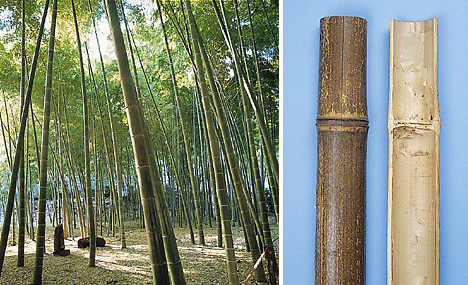Bamboo is a giant grass noted for the usefulness of its woody stem. Bamboos are distantly related to wheat, oats, and barley. But unlike these crop grasses, most bamboos are of giant size. Some may stand as much as 130 feet (40 meters) high and have stems more than 1 foot (30 centimeters) in diameter. Bamboo stems are used as fishing poles and in ornamental screens, cooking utensils, tools, baskets, and building material.

Scientists rank bamboos among the most primitive of grasses. There are hundreds of species (kinds) of bamboos. Most grow naturally in tropical climates or in the warm regions of temperate climates. Two small bamboos are native to the United States. They grow in the southeastern states, in thickets known as canebrakes.
How bamboo is used.
Bamboo provides many essential articles for people who live in tropical countries, especially Asian lands. Farmers may live in bamboo houses, sit on bamboo chairs, and eat food prepared in bamboo containers. Their beds and covers may be bamboo mats. They wear sandals woven from bamboo strips. Bamboo cages hold chickens and pigs, and a bamboo fence may enclose a yard. Bamboos provide shade, and tender young bamboo sprouts are eaten as vegetables. Paper, rafts, sails, textiles, tools, and towrope are also made from bamboo. Bamboo probably has more uses than any other plant in tropical countries.
Bamboos have been grown in the United States mostly for ornament. The United States Department of Agriculture maintains a bamboo garden near Savannah, Georgia. There, experts grow bamboo and test it. They have found that the closely matted roots help control soil erosion, and the high cellulose content of bamboo stems makes excellent pulp for paper. Construction engineers also use bamboo. Experts who compared the strength of laminated (layered) bamboo with soft steel found that the bamboo’s breaking point nearly equaled that of the steel. The strong, lightweight bamboo makes an excellent reinforcement for concrete.
How bamboo grows.
Bamboo usually grows from new shoots that sprout from the base of the mature plant. The shoots grow quickly. One bamboo grew 36 inches (91 centimeters) in 24 hours. Not all of these plants grow that fast, but they reach full height within a few months. Old clumps that have stored much food produce the largest and tallest bamboos.
The jointed stem never gets thicker after a bamboo is full grown. Bamboo stems do not add a ring of growth each year as tree trunks do. Bamboo leaves are long and narrow and grow alternately in two rows on opposite sides of the stem. When the leaves mature, the blades usually fall off, leaving the sheathlike base.
Many bamboos rarely bloom. Among these bamboos, different plants of the same species flower synchronously (at the same time) no matter where they grow. These bamboos bloom at intervals of from 10 to 120 years, depending on the species. Even if they are transplanted to other continents, these plants will flower at the same time and usually die after they bloom. New plants grow from the seeds, which look like rice kernels. In 1990, scientists announced development of a technique that causes bamboo to flower rapidly. This discovery may enable scientists to breed a type of bamboo that grows and reproduces faster than other bamboos.
